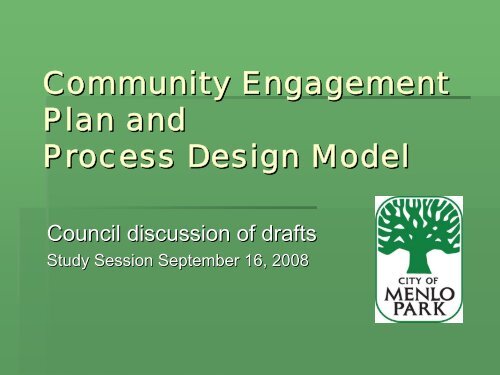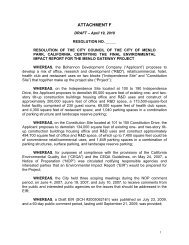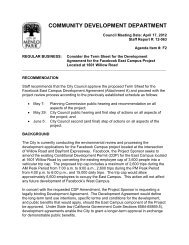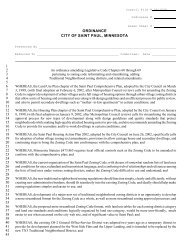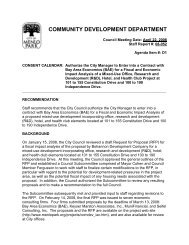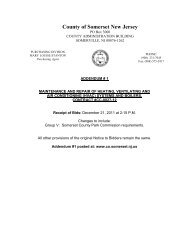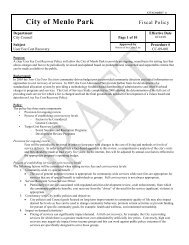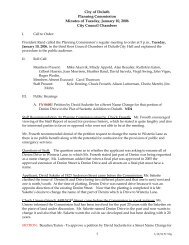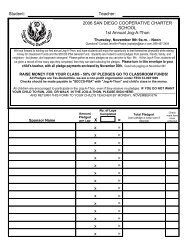Presentation - GovDelivery
Presentation - GovDelivery
Presentation - GovDelivery
- No tags were found...
Create successful ePaper yourself
Turn your PDF publications into a flip-book with our unique Google optimized e-Paper software.
Community EngagementPlan andProcess Design ModelCouncil discussion of draftsStudy Session September 16, 2008
Council Goal• Create meaningful opportunities forcommunity members to have a voice inCity decision-making and engage indialog with each other in order to helpCity Council and staff understandcommunity values, needs and concernsand develop policies, programs andservices that are responsive to them.
Study session approach• Overview of the plan• Overview of the model• Council discussionand feedback• Desired next steps
Study session outcome• Council direction confirming theorganization’s s intent to use the model forcommunity engagement processplanning.• Confirm intent to implement the plan asproposed.
Study session approach• Overview of the plan• Overview of the model• Council discussionand feedback
Plan development• Over 40 interviews• Themes from interviews form thebasis of the Plan
Plan follows GuidingPrinciples• Open vs closed• Decentralized vs centralized• Proactive vs reactive• Strongly themed vs scatteredmessages
Plan purpose andoutcomes• Outline Menlo Park’s s commitment tocommunity engagement• Define what community engagementmeans• Describe effective strategies forcommunity engagement• Provide a framework for evaluatingeffectiveness
Finding #1Focused messaging is needed• Goal• Promote the open, responsive and responsiblephilosophy of Menlo Park City governmentthrough development and use of organization-wide key messages
Strategies to focusmessaging• Integrate Council goals and priorities• Use Organizational Plan• Overall graphic look• Support Departments
Finding #2Proactive communication is vital• Goal• Promote community understanding of basicservices and how to access them.
Strategies for proactivecommunication• Keep communication focused• Keep language accessible• Methods meet audience needs• Keep it timely• Use multiple methods
Communication methodsinclude:• Direct outreach• Budget Report• Newsletter• Media relations• Releases, briefings, etc• Training
Communication methodsinclude:• On-line methods• Website• Email groups / subscription• CCIN and Direct Connect• Meeting streaming• Researching managed e-forume
Communication methodsinclude:• Personal methods• Meetings• Phone trees• Events and exhibits• Media Center programming
Finding #3People must feel that their inputmatters• Goal• Clarify expectations from the beginning ofcommunity engagement processes so that residentsunderstand how their input will be used. Clearly linkinput with results in a “you said X so we did X” Xformat.• Strategy• The process design model includes methods forincreasing participation
Finding #4Clear roles and responsibilities areneeded for those involved incommunity engagement processes• Goal• Clarify roles and responsibilities of all stakeholdersat the outset. For each process, specify thepromises to various stakeholders about their roleand the use of their input.• Strategy• The process design model includes methods forincreasing participation
Finding #5Informed residents and opportunitiesfor real dialogue lead to “betterdecisions”• Goal• Provide participants with elements needed formeaningful engagement: factual information;meetings constructed to engage people in smallgroups; adequate time for dialogue; multipleopportunities for input• Strategy• The model includes a series of steps ensuringmeaningful engagement by promoting thedevelopment of public judgment
Finding #6Increased, broader participation leadsto implementable decisions• Goal• Increase both the breadth and depth ofresident and other stakeholder participationin community engagement processes.• Strategy• The Process Design Model includesmethods for increasing participation
Finding #7Council participation in and use ofcommunity engagement processes hasa major impact on process outcomes• Goal• Support Council in developing a consistent,predictable and transparent community engagementapproach that includes clarification of their role ineach process.• Strategy• Consistent use of the Model should supportsuccessful community engagement outcomes.
Finding #8Council, Commissions and staff havethe desire to engage the community;other capacities need to be built• Goal• Ensure that Council, Commissions and staff havethe support and resources needed to design andimplement meaningful community engagement.• Strategy• Ongoing support from the Community EngagementManager and an organizational culture nurturing theprinciples of the Model should help build capacity.
The next six months• Clarify key messages• Newsletter• E mail lists• Web page• Traditional media• Media policy / training
The next six months• Media center programming• CE Guidebook and model training• Clarify Commission roles and providesupport• CCIN response refinement• Direct Connect reintroduction
Community EngagementModel Overview• A systematic way to design communitydecision-making processes
Council Goal• Create meaningful opportunities forcommunity members to have a voice inCity decision-making and engage indialog with each other in order to helpCity Council and staff understandcommunity values, needs and concernsand develop policies, programs andservices that are responsive to them.
What we’re striving for• The ultimate goal of communityengagement is to make decisionsreflecting a lasting public or communityjudgment.• Sense of trust in local government.• Increased sense of community.
Expectations forcommunity engagement• Not about making everyone happy.• Community engagement is NOT a curefor conflict or a magic bullet.• Community engagement activitiessurface conflict and provide a proven,productive way to manage it.
Core values of the Model• Open• Honest• Fair
An open, honest, fairprocess must• Provide safe venues and ground rules allowingdisagreement while protecting participants• Create settings so that people can deliberatethoughtfully and with accountability toward oneanother• Discussions focused on the goal of a solution,rather than supporting entrenched positions
An open, honest, fairprocess must• Provide ways for people to express andunderstand underlying sets of values• Replace opinion with judgment throughinformation and the sharing of experience
Three Stages of PublicParticipation Planning• Stage One: Decision Analysis• Problem• Level• Givens• Stakeholders• Stage Two: Process Planning• Sequence of decisions – getting to judgmentand consensus• Stage Three: Implementation planning
Stage One: Decision Analysis1. Define the problem or opportunity• Connects with people’s s self interest at thebroadest level to “sell the problem”• Compels participation while setting thestage for the broadest level of agreementpossible
Stage One: Decision Analysis2. Determine the level of engagementneeded to assure “legitimacy”• Inform – provide the community withinformation for understanding• Consult – obtain public feedback on needs/ values, alternatives, and decisions• Involve – work w/ community throughoutprocess understand and consider concernsand aspirations• Collaborate – partner in each aspect ofdeveloping alternative and choosing thepreferred solution
Stage One: Decision Analysis3. Project Givens:• Givens are the elements of a decision theorganization would be irresponsible to put upfor discussion.• “Curbs” or “the box” within which thecommunity will make a decision or provideinput.• Usually, describe legal, moral and ethical,safety or financial constraints.• One of the most important considerations isdeciding who will make the final decision –what role does Council expect to play in theprocess?
Stage One: Decision Analysis4. Determine stakeholders andinterests:• Stakeholders are groups and individualswho will be affected by or who will likelycare about the problem or opportunity tobe addressed.• Interests are… the things the stakeholderscare about
Stage TwoWhat sequence of decisionsis needed to developpublic judgment?
Key concepts for thesequence1. Public Judgment:• An overarching goal for all communityengagement processes• Legitimate, lasting and supportable• Distinguished from public opinion that isnot dependant upon factual informationand consideration of broader interests
Key concepts for thesequence2. Consensus• Described as a decision everyoneagrees to live with, even though peoplemay have had to give up somethingthey wanted and did not achieve theirsolution of first choice• Consensus is not unanimity
Consensus assumptions• There is common ground amongconflicting interests• People who disagree need not beadversaries• There is legitimacy to every perspective• People will work to accommodate eachother’s s needs
Sequencing for Consensus• Provides equal opportunity for everyoneto influence the outcome• Gives participants the ability to findcommon ground and discuss choicesother than yes or no• Encourages solutions representingmultiple alternatives• Allows “win-win” results without a voteto reinforce sense of community
Consensus decisionsbalance competing valuesOne thing thecommunitythinks is goodAnother thingthe communitythinks is goodAnother thingthe community thinks isgoodOption A Option B Option C
Stage Two: Sequence ofDecisions• For public judgment and consensus:Livedexperience/ publicopinion+ TechnicalexpertiseDeliberationPublicjudgment
Sequence of DecisionsValues / lived experiencesInformation sharingDeliberation /ChoiceSolution
Sequence of DecisionsValues / lived experiencesInformation sharingDeliberation /ChoiceSolution
Sequence of DecisionsValues / lived experiencesInformation sharingDeliberation /ChoiceSolution
Sequence of DecisionsValues / lived experiencesInformation sharingDeliberation /ChoiceSolution
More specifics• Model Guidebook includes a “toolkit” ofmethods with information about bestuses and other tips
Stage Three:Implementation planning• Develop a supporting communicationsplan• Plan for data collection and analysis• Plan for individual activities• Evaluate
What’s s Council’s s role inuse of the Model?• Consistent with Carl Neu• Identify and focus issues• Facilitate sharing of information on issues• Develop consensus on appropriate actions• Ratify the emergent consensus• Maintain support for action taken
The role of leaders• Identify the problem to be solved• Communicate the problem to the impactedpublics• Decide what role public participants will play andwhat elements of a decision are not negotiable• Hear first hand and genuinely consider theideas, wants and desires of people when makingthe final decision• Hold to the process and allow no compromising• Absolutely refrain from any old-fashioned“dealcutting”
The role of staff• Provide information, using technical expertiseand professional experience to describe options,their pros and cons; benefits and implications tomake sound decisions possible• Design and carry out community decisionprocesses.• Help people turn uninformed opinion into publicjudgment• Track input and provide feedback on results tothe participants and the decision makers• Act as champions for community engagement
The role of Commissions(suggested) and Committees• Support processes that align and clarify theresponsibilities of Commissions with theresponsibilities placed on participants andCouncil• Bring experience and perspective in helping todefine the problem or opportunity and developalternatives• Personally promote attendance and participation• Host meetings and attend others• Honor the process results in decision makingand incorporate into Council recommendations
What happens next• Lots of training and learning for staff,Commissions, others• We will all be learning these newapproaches together• Experience is a great teacher
Questions• Does this sound like a model Council andthe organization can commit to using forprocess design?• Does Council supportplan implementationas proposed?


